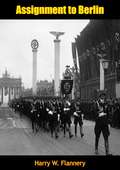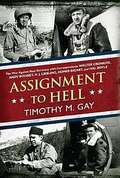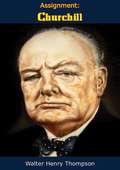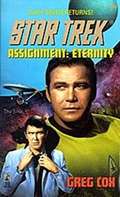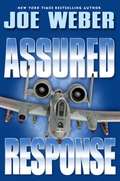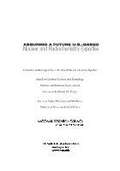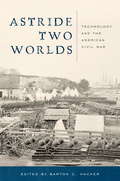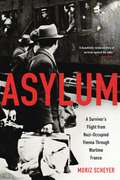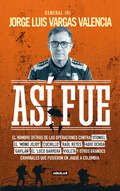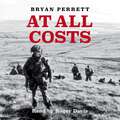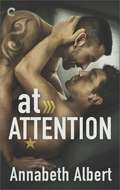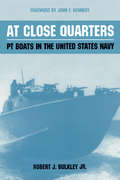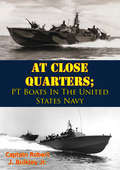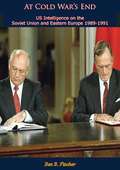- Table View
- List View
Assignment to Berlin
by Harry W. FlanneryBy the man who succeeded William L. Shirer as the Berlin correspondent of the Columbia Broadcasting System, Assignment to Berlin by U.S. journalist and author Harry W. Flannery, first published in 1942, covers Germany in the crucial year 1941.Packed with lively incident, shrewd comment and startling information, it brings the story of life in Hitler’s domain up to the eve of America’s entry into the war.
Assignment to Hell: The War Against Nazi Germany with Correspondents Walter Cronkite, Andy Rooney, A. J. Liebling, Homer Bigart, and Hal Boyle
by Timothy M. GayTHEIR WORK ON THE FRONT LINES MADE HEADLINES In February 1943, a group of journalists—including a young wire service correspondent named Walter Cronkite and cub reporter Andy Rooney—clamored to fly along on a bombing raid over Nazi Germany. Seven of the sixty-four bombers that attacked a U-boat base that day never made it back to England. A fellow survivor, Homer Bigart of the New York Herald Tribune, asked Cronkite if he’d thought through a lede. “I think I’m going to say,” mused Cronkite, “that I’ve just returned from an assignment to hell. ” During his esteemed career Walter Cronkite issued millions of words for public consumption, but he never wrote or uttered a truer phrase. Assignment to Hell tells the powerful and poignant story of the war against Hitler through the eyes of five intrepid reporters. Crisscrossing battlefields, they formed a journalistic band of brothers, repeatedly placing themselves in harm’s way to bring the war home for anxious American readers. Cronkite crashed into Holland on a glider with U. S. paratroopers. Rooney dodged mortar shells as he raced across the Rhine at Remagen. Behind enemy lines in Sicily, Bigart jumped into an amphibious commando raid that nearly ended in disaster. The New Yorker’s A. J. Liebling ducked sniper fire as Allied troops liberated his beloved Paris. The Associated Press’s Hal Boyle barely escaped SS storm troopers as he uncovered the massacre of U. S. soldiers during the Battle of the Bulge. Assignment to Hell is a stirring tribute to five of World War II’s greatest correspondents and to the brave men and women who fought on the front lines against fascism—their generation’s “assignment to hell. ” .
Assignment: Churchill
by Walter Henry ThompsonAN UNIQUE, INTIMATE VIEW OF WINSTON CHURCHILL BY THE MAN WHO GUARDED HIM NIGHT AND DAY FOR 20 MOMENTOUS YEARS.When Tommy Thompson as assigned to guard Winston Churchill by Scotland Yard he shuddered. Churchill was considered a tough assignment and Thompson had had his share of tough ones. From Lloyd George to King Alexander of Yugoslavia. But he did it for almost 20 years.Here is a delightful intimate view of the great statesman and his contemporaries—Lawrence of Arabia, F.D.R., Joseph Stalin, seen with the well-trained eye of a Scotland Yard man.“As intimate a portrait of Churchill as has ever been committed to print.”—San Francisco Chronicle“A supremely colorful man, chewing on his dead cigars striking matches on the walls of the kremlin parading naked before an embarrassed President Roosevelt—indifferent to the lesser things in life, but never missing the main chances of his destiny.”—New York Times“Gripping...Churchill’s biographers will unquestionably have to draw on this book by the officer who was the great man’s shadow for 20 years.”—Saturday Review Syndicate“If it’s suspense and excitement you seek in a book...just read ASSIGNMENT: CHURCHILL.”—Los Angeles Times
Assignment: The Original Series #84
by Greg CoxCaptain Kirk first encountered Gary Seven on twentieth-century Earth. Now Seven, a time-traveling operative for unknown alien forces, makes a surprise visit to the U.S.S. Enterprise. Kirk is on an urgent mission to bering relief to a disaster ravaged planet, but Seven has an agenda of his own -- and he's not above hijacking the Starship Enterprise and sending it on a perilous journey deep into the heart of the Romulan Empire. Kirk must date to trust Gary Seven once again, as he confronts the possibility that the enigmatic stranger may bring death and destruction to Kirk's own era.
Assize of Arms: The Disarmament of Germany and Her Rearmament (1919-1939)
by J. H. MorganBritish lawyer and Brigadier-General John Hartman Morgan served as Deputy Adjutant-General in Berlin from 1919-1923 at the Inter-Allied Military Commission of Control—a term used in a series of peace treaties concluded after World War I (1914-1918) between different countries. Each of these treaties was concluded between the Principal Allied and Associated Powers (consisting of the United States of America, the British Empire, France, Italy and Japan) on the one hand, and one of the Central Powers like Germany, Turkey or Bulgaria.One of the terms of such treaties required conversion of all of the Central Powers’ military and armaments related production and related facilities into purely commercial use. The decision and the modus operandi to ensure this rested with a Military Inter-Allied Commission of Control. The Military Inter-Allied Commission of Control was also entrusted with a number of other responsibilities, including (a) setting the number of customs officials, local urban and rural police, forest guards and other officials under the control of the Government of the central power concerned; and (b) receiving information relating to the location of the stocks and depots of arms, munitions and war material and their operations.It was during this period of 1919-1923 that Brig.-Gen. Morgan witnessed German attempts to build up their army contravening the terms of the Treaty of Versailles, and he published his findings in October 1924 in the Quarterly Review, titled “The Disarmament of Germany and After.” However, it would not be until after World War II that he would decide to elaborate on this theme—the result is the present volume, Assize of Arms: The Disarmament of Germany and Her Rearmament (1919-1939).First published in 1945, it was intended to be published in two volumes; however, owing to Brig.-Gen. Morgan’s passing in 1955, it remained as a single volume.A valuable addition to any World Wars library.
Assured Response (Scott Dalton and Jackie Sullivan #3)
by Joe WeberNew threats require new weapons. New villains require new heroes. The time is the near future. Osama Bin Laden has been succeeded by a generation of even deadlier terrorists who will stop at nothing in their fanatical quest to destroy the United States. Conventional security is no longer enough. Former military pilots Scott Dalton and Jackie Sullivan are the government's newest weapons--operatives so secret that their very existence is denied by the officials who hired them. Armed with the most up-to-date technology and equipment, their mission is to prevent a plan of nuclear holocaust that will begin at the Canadian border and explode in the centers of American power. They have their work cut out for them. Foremost among their foes are Saeed Shayhidi, a billionaire Iranian "businessman" and mass murderer, far more sophisticated and sadistic than Bin Laden himself; Khaliq Farkas, a mysterious and ever-elusive terrorist, bearing a barbaric grudge; and Zheng-Yen Tsung, the powerful Chinese official who may be the mastermind behind it all. From a shocking sarin attack on a legendary ocean liner to the stalking of chemical plants and oil refineries by aircraft filled with explosives, no attack is too insidious, no symbol of strength and freedom immune. For Dalton and Sullivan, their expertise has never been more necessary--their bravery never more needed--than in a world where unrepentant evil requires an assured response.
Assuring a Future U.S.-Based Nuclear and Radiochemistry Expertise
by Committee on Assuring a Future U.S.-Based Nuclear Chemistry ExpertiseThe growing use of nuclear medicine, the potential expansion of nuclear power generation, and the urgent needs to protect the nation against external nuclear threats, to maintain our nuclear weapons stockpile, and to manage the nuclear wastes generated in past decades, require a substantial, highly trained, and exceptionally talented workforce. <P><P>Assuring a Future U.S.-Based Nuclear and Radiochemistry Expertise examines supply and demand for expertise in nuclear chemistry nuclear science, and radiochemistry in the United States and presents possible approaches for ensuring adequate availability of these skills, including necessary science and technology training platforms.<P>Considering a range of reasonable scenarios looking to the future, none of these areas are likely to experience a decrease in demand for expertise. However, many in the current workforce are approaching retirement age and the number of students opting for careers in nuclear and radiochemistry has decreased dramatically over the past few decades. In order to avoid a gap in these critical areas, increases in student interest in these careers, in the research and educational capacity of universities and colleges, and sector specific on-the-job training will be needed. Concise recommendations are given for actions to avoid a shortage of nuclear chemistry, nuclear scientists, and radiochemists in the future.
Astride Two Worlds
by Barton C. HackerBy the middle of the nineteenth century, industrialization and military-technological innovation were beginning to alter drastically the character and conditions of warfare as it had been conducted for centuries. Occurring in the midst of these far-reaching changes, the American Civil War can justly be labeled both the last great preindustrial war and the first major war of the industrial age. Industrial capacity attained new levels of military significance as transportation improved, but in this, as in many other respects, the Civil War was distinctly transitional. Smoothbore artillery still dominated the battlefield, horse-drawn wagons and pack mules still carried the main logistic burden, seamstresses still outnumbered sewing-machine operators. Astride Two Worlds addresses the various causes and consequences of technological change for the course and outcome of the American Civil War.
Astropolitik: Classical Geopolitics in the Space Age (Strategy and History)
by Everett C. DolmanThis volume identifies and evaluates the relationship between outer-space geography and geographic position (astrogeography), and the evolution of current and future military space strategy. In doing so, it explores five primary propositions.
Asylum: A Survivor's Flight from Nazi-Occupied Vienna Through Wartime France
by P. N. Singer Moriz ScheyerA recently discovered account of an Austrian Jewish writer's flight, persecution, and clandestine life in wartime France.As arts editor for one of Vienna's principal newspapers, Moriz Scheyer knew many of the city's foremost artists, and was an important literary journalist. With the advent of the Nazis he was forced from both job and home. In 1943, in hiding in France, Scheyer began drafting what was to become this book. Tracing events from the Anschluss in Vienna, through life in Paris and unoccupied France, including a period in a French concentration camp, contact with the Resistance, and clandestine life in a convent caring for mentally disabled women, he gives an extraordinarily vivid account of the events and experience of persecution. After Scheyer's death in 1949, his stepson, disliking the book's anti-German rhetoric, destroyed the manuscript. Or thought he did. Recently, a carbon copy was found in the family's attic by P.N. Singer, Scheyer's step-grandson, who has translated and provided an epilogue.
Asymmetric Warfare in South Asia: The Causes and Consequences of the Kargil Conflict
by Peter R. LavoyThe 1999 conflict between India and Pakistan near the town of Kargil in contested Kashmir was the first military clash between two nuclear-armed powers since the 1969 Sino-Soviet war. Kargil was a landmark event not because of its duration or casualties, but because it contained a very real risk of nuclear escalation. Until the Kargil conflict, academic and policy debates over nuclear deterrence and proliferation occurred largely on the theoretical level. This deep analysis of the conflict offers scholars and policymakers a rare account of how nuclear-armed states interact during military crisis. Written by analysts from India, Pakistan, and the United States, this unique book draws extensively on primary sources, including unprecedented access to Indian, Pakistani, and U. S. government officials and military officers who were actively involved in the conflict. This is the first rigorous and objective account of the causes, conduct, and consequences of the Kargil conflict.
Asymmetric Warfare: Politics and Cultures of Violence in the Modern Era (Elements in Modern Wars)
by Jacob HagstromThe forces that fight asymmetric wars are so distinct that one side avoids direct military confrontation in favor of political, social, or otherwise unorthodox means of resistance. These conflicts have been a mainstay of modern times, though scholars have often separated them into various designations by era. Observers have referred, in chronological order, to Indian warfare, petite guerre (small war), guerrilla warfare, irregular or revolutionary war, and terrorism. The proliferation of labels over time has obscured the continuity of asymmetric wars throughout modernity. Stark distinctions in resources and capabilities have shaped the reasons why states and societies have decided to fight, and the manner in which they have fought. Across the modern era, mismatches arose in the domains of technology, intelligence production, and law. But in recent decades, so-called weak powers have neutralized many of the typical advantages of strong military states.
Asymmetrical Warfare On The Great Plains: A Review Of The American Indian Wars-1865-1891
by Lieutenant Colonel Lowell Steven YarbroughThe American Indian policy, formulated at the turn of the 19th century, significantly impacted the national military strategy. President Jefferson's plan for Indian removal became the cornerstone for federal policy. Congress would bear the responsibility for crafting the nation's Indian policies, but the burden for execution was left to an unprepared and undermanned Army.From the end of the Civil War to the beginning of the Spanish-American War in 1898, the principal mission of the Army was fighting Indians. Returning to the Western frontier the Army attempted to fight the Indians using the tactics that proved successful in the Civil War. The diverse Great Plains tribes, using raids and ambushes, successfully fought a thirty-year war against a superior military force. It would finally take the unorthodox tactics of several field commanders to bring an end to the fighting.This paper examines the national policy and the means used to implement it. The paper examines asymmetrical warfare through its discussion on critical shortcomings in military preparedness and strategy. The past several conflicts that U.S. military forces have participated in (Somalia, Haiti, Bosnia, Kosovo, and Afghanistan) suggest that the American Indian Wars offer valuable strategic lessons.
Asymmetries of Conflict: War Without Death
by John LeechDecisions about defence and security are becoming increasingly open to public influence. This book therefore aims to give both the voter and the decision maker a new vision of how to manage crises and avert hostilities with non-traditional means.
Así fue
by Jorge Luis Vargas ValenciaEL HOMBRE DETRÁS DE LAS OPERACIONES CONTRA 'OTONIEL', EL 'MONO JOJOY', 'CUCHILLO', 'RAÚL REYES', FABIO OCHOA, 'GAVILÁN', EL 'LOCO BARRERA', VIOLETA Y OTROS GRANDES CRIMINALES QUE PUSIERON EN JAQUE A COLOMBIA Por más de 30 años, el general (r) Jorge Luis Vargas Valencia persiguió y atrapó a los criminales más buscados de Colombia. Su trabajo, valentía y resultados lo llevaron a obtener el máximo grado que un policía puede recibir en el país y a convertirse en director general de la Policía Nacional, cargo que ocupó hasta la llegada al poder del actual presidente Gustavo Petro. Durante esas tres décadas, el mundo ha sido testigo de cómo las carreras delictivas de 'Otoniel', el 'Mono Jojoy', 'Raúl Reyes', Violeta, Fabio Ochoa y 'Cuchillo', entre muchos otros, terminaron en una celda o en una tumba como consecuencia de operaciones en las que Vargas cumplió un papel fundamental. En este libro, el general en retiro se viste de cronista para revivir cómo fue la planeación de esas acciones cinematográficas y revela los secretos que pusieron en marcha su ejecución: un comando entrenado sumergido en un manglar durante catorce días para capturar a un gran capo, ocho años de espera para infiltrar los corredores de comunicación del otrora gran jefe del Clan del Golfo, toda la inteligencia del Estado al servicio de la Policía y el Ejército para dar de baja a 'Raúl Reyes', el rastreo a los movimientos y transacciones de Alex Saab para identificar su entramado, y muchas otras historias que sorprenderán incluso a los lectores más enterados. En Así fue, Jorge Luis Vargas Valencia también reflexiona sobre el presidente Gustavo Petro, el gobierno actual y los retos de ese país violento y armado que ha recorrido hasta la médula.
At All Costs
by Bryan PerrettFrom the jaws of defeat, incredible victories.AT ALL COSTS! transports you to the battlefront for over two centuries of astonishing military confrontations. From the Battle of Minden in 1795 to dramatic second world war stories and the Battle for Goose Green in the Falklands, Bryan Perrett gives astoundingly vivid accounts of international forces in daring actions, achieving victory against the odds.These real-life military adventures are meticulously, accurately described, giving a true flavour of some of the most important moments in world history.
At All Costs
by Bryan PerrettFrom the jaws of defeat, incredible victories.AT ALL COSTS! transports you to the battlefront for over two centuries of astonishing military confrontations. From the Battle of Minden in 1795 to dramatic second world war stories and the Battle for Goose Green in the Falklands, Bryan Perrett gives astoundingly vivid accounts of international forces in daring actions, achieving victory against the odds.These real-life military adventures are meticulously, accurately described, giving a true flavour of some of the most important moments in world history.
At All Costs: Stories Of Impossible Victories (Cassell Military Classics Ser.)
by Bryan PerrettFrom the jaws of defeat, incredible victories.
At Any Price: The ANZACS at the Battle of Messines 1917
by Craig DeaytonThe enemy must not get the Messines Ridge at any price… So read the orders to German troops defending the vital high ground south of Ypres. On 7 June 1917, the British Second Army launched its attack with an opening like no other. In the largest secret operation of the First World War, British and Commonwealth mining companies placed over a million pounds of explosive beneath the German front-line positions in 19 giant mines which erupted like a volcano. This was just the beginning. By the end of that brilliant summer&’s day, one of the strongest positions on the Western Front had fallen in the greatest British victory in three long years of war. For the ANZACs, who comprised one third of the triumphant Second Army, it was their most significant achievement to that point; for the men of the New Zealand Division, it would be their finest hour. It is difficult to overstate the importance of Messines for the Australians, whose first two years of war had represented an almost unending catalogue of disaster. This was both the first real victory for the AIF and the first test in senior command for Major General John Monash, who commanded the newly formed 3rd Division. Messines was a baptism of fire for the 3rd Division which came into the line alongside the battle-scarred 4th Australian Division, badly mauled at Bullecourt just six weeks earlier. The fighting at Messines would descend into unimaginable savagery, a lethal and sometimes hand-to-hand affair of bayonets, clubs, bombs and incessant machine-gun fire, described by one Australian as &‘72 hours of Hell&’. After their string of bloody defeats over 1915 and 1916, Messines would prove the ultimate test for the Australians.
At Attention
by Annabeth AlbertLieutenant Apollo Floros can ace tactical training missions, but being a single dad to his twin daughters is more than he can handle. He needs live-in help, and he's lucky a friend's younger brother needs a place to stay. He's surprised to see Dylan all grown up with a college degree...and a college athlete's body. Apollo's widowed heart may still be broken, but Dylan has his blood heating up. It's been eight years since the teenage Dylan followed Apollo around like a lovesick puppy, and it's time he showed Lieutenant Hard-to-Please that he's all man now-an adult who's fully capable of choosing responsibility over lust. He can handle Apollo's muscular sex appeal, but Apollo the caring father? Dylan can't afford to fall for that guy. He's determined to hold out for someone who's able to love him back, not someone who only sees him as a kid brother. Apollo is shocked by the intensity of his attraction to Dylan. Maybe some no-strings summer fun will bring this former SEAL back to life. But the combination of scorching desire and warm affection is more than he'd expected, and the emotion between them scares him senseless. No fling lasts forever, and Apollo will need to decide what's more important-his past or his future-if he wants to keep Dylan in his life. Book Two of the Out of Uniform series This book is approximately 73,000 words One-click with confidence. This title is part of the Carina Press Romance Promise: all the romance you're looking for with an HEA/HFN. It's a promise!
At Close Quarters
by Robert J. BulkleySmall though they were, PT boats played a key role in World War II, carrying out an astonishing variety of missions where fast, versatile, and strongly armed vessels were needed. Called "weapons of opportunity," they met the enemy at closer quarters and with greater frequency than any other type of surface craft. Among the most famous PT commanders was John F. Kennedy, whose courageous actions in the Pacific are now well known to the American public. The author of the book, another distinguished PT boat commander in the Pacific, compiled this history of PT-boat operations in World War II for the U.S. Navy shortly after V-J Day, when memories were fresh and records easily assessable. The book was first made available to the public in 1962 after Kennedy's inauguration as president of the United States interest in PTs was at a peak.Bulkley provides a wealth of facts about these motor torpedo boats, whose vast range of operation covered two oceans as well as the Mediterranean and the English Channel. Although their primary mission was to attack surface ships and craft close to shore, they were also used effectively to lay mines and smoke screens, to rescue downed aviators, and to carry out intelligence and raider operations. The author gives special attention to the crews, paying well-deserved tribute to their heroism, skill, and sacrifice that helped to win the war.
At Close Quarters; PT Boats In The United States Navy [Illustrated Edition]
by Rear Admiral Earnest McNeill Eller President John F. Kennedy Captain Robert J. Bulkley Jr.Includes over 110 illustrations charting the history of the US Navy PT Boats."The destiny of our country has been inextricably interwoven with the sea. This was never more true than in the giant World War II that involved all seas and most of mankind. To fight the sea war we needed many types of ships, large and small, from aircraft carriers and battleships to PT boats."Small though they were, the PT boats played a key role. Like most naval ships, they could carry out numerous tasks with dispatch and versatility. In narrow waters or in-fighting close to land they could deliver a powerful punch with torpedo or gun. On occasion they could lay mines or drop depth charges. They could speed through reefs and shark infested waters to rescue downed pilots or secretly close the shore to make contacts with coast watchers and guerrilla forces. PT boats were an embodiment of John Paul Jones' words:"I wish to have no connection with any ship that does not sail fast for I intend to go in harm's way.""Naval strength must function from shore to shore and on inland waters where the mobility and flexibility provided by ships can be employed to support land operations. PT boats filled an important need in World War II in shallow waters, complementing the achievements of greater ships in greater seas. This need for small, fast, versatile, strongly armed vessels does not wane. In fact it may increase in these troubled times when operations requiring just these capabilities are the most likely of those which may confront us."The thorough and competent account herein of over-all PT boat operations in World War II, compiled by Captain Robert Bulkley, a distinguished PT boat commander, should therefore prove of wide interest. The widest use of the sea, integrated fully into our national strength, is as important to America in the age of nuclear power and space travel as in those stirring days of the birth of the Republic."-President John F Kennedy.
At Close Range (Tracers #11)
by Laura GriffinNew York Times bestselling author Laura Griffin &“delivers the goods&” (Publishers Weekly) again with the eleventh title in the gritty, heart-pounding Tracers series.When a lakeside tryst ends in a double murder, police detective Daniele Harper arrives on the scene determined to get answers. Clues are everywhere, but nothing adds up. Dani turns to the Delphi Center crime lab for help, but soon regrets it when her secret attraction to their chief firearms examiner threatens to distract her from the most important case of her career. As a ballistics expert and former Navy SEAL, Scott Black knows firearms, and he knows he can help Dani unravel her case. Scott has managed to hide his interest in his best friend’s younger sister for years, but when her investigation brings them together, the sparks between them quickly burn out of control. Scott resolves to keep his hands off Dani and his eyes on the goal—identifying a killer. But when that killer zeroes in on her, all bets are off. There isn’t a line Scott won’t cross to convince Dani to trust him so that he can help her take down a ruthless murderer who has her in his sights.
At Close Range: One Regiment 1939 - 1945
by Peter HartThe best way to understand what it was like to fight in the Second World War is to see it through the eyes of the soldiers who fought it. The South Notts Hussars fought at almost every major battle of the Second World War, from the Siege of Tobruk to the Battle of El Alamein and the D-Day Landings.Here, Peter Hart draws on detailed interviews conducted with members of the regiment, to provide both a comprehensive account of the conflict and reconstruct its most thrilling moments in the words of the men who experienced it.This is military history at its best: outlining the path from despair to victory, and allowing us to share in soldiers' hopes and fears; the deafening explosions of the shells, the scream of the diving Stukas and the wounded; the pleasures of good comrades and the devastating despair at lost friends.
At Cold War's End: U.S. Intelligence on the Soviet Union and Eastern Europe 1989-1991
by Ben B. FischerThe last great drama of the Cold War—the collapse of communism in the Soviet Union and Eastern Europe and the end of the four-decade-old East-West conflict—unfolded in three acts between 1989 and 1991. Even as the story began, Soviet leader Mikhail Gorbachev already had made the largest opening to the outside world in Russian history. To convince the West, and above all the new administration in Washington, of his sincerity, Gorbachev had made major concessions on arms control, withdrawn Soviet troops from Afghanistan, pledged to reduce Soviet ground forces by half a million, and rejected class warfare in favor of “pan-human values” as the basis of Soviet foreign policy...The second act of the drama began in the fall of 1989 with peaceful revolutions in Eastern and Central Europe (except Romania) and the fall of the Soviet “outer empire.” The de facto collapse of the Warsaw Pact (it would formally dissolve itself a year later) plus a new treaty that substantially reduced Soviet superiority in conventional forces in Europe resulted in a stronger Western alliance—so strong that the US could redeploy forces from Europe to the Persian Gulf for use against Iraq...The third and final act closed with the 1991 dissolution of the USSR. The centrifugal forces in the “outer empire” stimulated and accelerated those in the “inner empire” as the Soviet republics sought sovereignty and then independence from Moscow. At the same time, Gorbachev’s domestic reforms ran into serious trouble, and the economy went into a tailspin. Gorbachev’s struggle with the old imperial elite in the communist party, the armed forces, and the military-industrial complex culminated in the August 1991 coup, which, when it failed, finished off the USSR—and Gorbachev himself...The USSR officially ceased to exist on 31 December.
